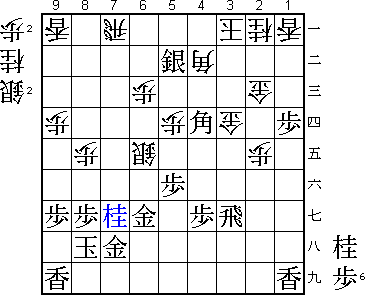11th Shinjin-O Match Game 1
Black: Miura, 6-dan
White: Hatakeyama Naruyuki, 6-dan
29th Shinjin-O-sen, Game 1, October 13th 1998
1.P7g-7f 0/0 0/0
An interesting match in the Shinjin-O this year between former Kisei Miura and
Hatakeyama Naruyuki, one of the professional Hatakeyama twins. Both players
are known for their defending style, so it was expected that this would be
a long fight...
2.P8c-8d 0/0 0/0
3.S7i-6h 4/4 0/0
4.P3c-3d 0/4 0/0
5.P6g-6f 0/4 0/0
6.S7a-6b 0/4 0/0
7.P5g-5f 0/4 0/0
8.P5c-5d 0/4 0/0
9.S3i-4h 0/4 0/0
10.S3a-4b 0/4 1/1
11.G4i-5h 0/4 0/1
12.G4a-3b 0/4 0/1
13.G6i-7h 0/4 0/1
14.G6a-5b 0/4 2/3
15.K5i-6i 0/4 0/3
16.P4c-4d 0/4 2/5
17.S6h-7g 0/4 0/5
18.S4b-3c 0/4 0/5
19.B8h-7i 0/4 0/5
20.B2b-3a 0/4 1/6
21.P3g-3f 0/4 0/6
22.G5b-4c 0/4 2/8
23.S4h-3g 0/4 0/8
24.S6b-5c 0/4 16/24
25.G5h-6g 1/5 0/24
26.K5a-4a 0/5 2/26
27.P2g-2f 2/7 0/26
Miura surprises his opponent with choosing a rather old-fashioned variation in
the Yagura opening. These days, this pawn push is usually postponed or not
played at all.
28.B3a-4b 0/7 10/36
29.B7i-6h 6/13 0/36
30.K4a-3a 0/13 1/37
31.K6i-7i 3/16 0/37
32.K3a-2b 0/16 19/56
33.K7i-8h 4/20 0/56
34.P7c-7d 0/20 11/67
35.S3g-4f 4/24 0/67
36.S5c-6d 0/24 3/70
37.P1g-1f 3/27 0/70
38.N8a-7c 0/27 17/87
39.S7g-8f 1/28 0/87
40.P9c-9d 0/28 4/91
41.N2i-3g 38/66 0/91
42.S3c-2d 0/66 1/92
43.P1f-1e 7/73 0/92
Now we have a position that was played a lot about ten years ago. Both players
were then still in the Shoreikai. Hatakeyama admitted that he had forgotten
the details about this position.
44.R8b-7b 0/73 23/115
The alternative is 44.P9e.
45.P3f-3e 81/154 0/115
46.P3dx3e 0/154 2/117
47.S4fx3e 3/157 0/117
48.S2dx3e 0/157 56/173
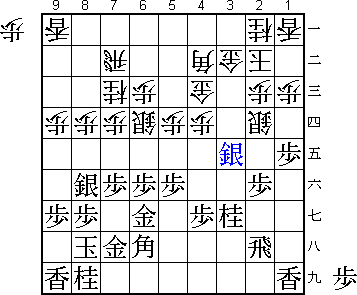
The obvious 48.P*3f N2e P3g+ is not so clear. Black's attack is still strong,
while white's rook is not doing much on 7b and might soon be attacked by a
silver drop on 8c. After long thought, Hatakeyama decides that he can not
win by only trying to stop black's attack. He needs to attack himself.
49.B6hx3e 1/158 0/173
50.P7d-7e 0/158 4/177
51.N3g-2e 48/206 0/177
52.S*2d 0/206 11/188
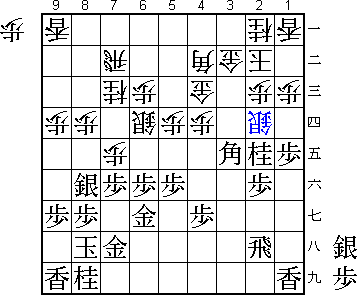
53.N2ex1c+!? 6/212 0/188
Very atypical for Miura's style. 53.B6h followed by P*3c Nx3c Nx1c+ is less
violent and seems the more safe way to attack. However, Miura correctly judges
that 53.B6h Px7f is a big problem. White threatens to win the silver with P8e,
and the defense P*7d N8e only helps white's attack. Miura: "Retreating the
bishop loses. I had to go for the all-out attack".
54.K2bx1c? 0/212 15/203
It seems like Hatakeyama was very confident about this move, but it is too
risky. Better was 54.Lx1c B6h Px7f P2e S3c P*7d N8e P1d Lx1d Lx1d S7e and
white has good attacking chances.
55.P1e-1d 18/230 0/203
56.K1c-2b 0/230 0/203
57.S*1c 0/230 0/203
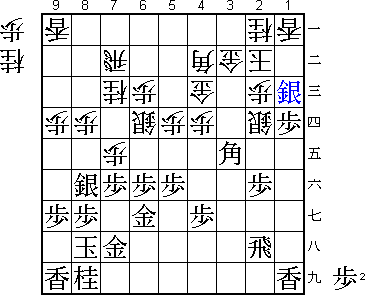
58.K2b-3a 0/230 21/224
58.Nx1c looks better, but the situation is very complicated.
59.S1cx2d+ 0/230 0/224
60.P2cx2d 0/230 0/224
61.P2f-2e! 13/243 0/224
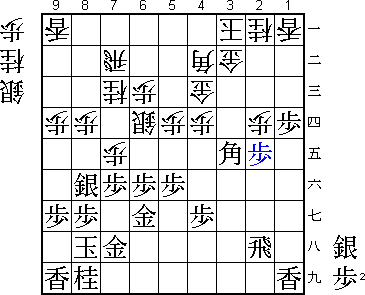
This is a great move by Miura. Hatakeyama expected 61.P1c+ Lx1c Lx1c+ Nx1c
P*1d Px7f Px1c+ L*7g with good chances for white. 61.P2e looks very slow,
but it is just fast enough.
62.P8d-8e 0/243 32/256
The natural 62.Px7f is no longer good, because of Px2d P*2b P1c+ Lx1c Lx1c+
Nx1c P2c+ Gx2c Rx2c+! and black wins. Also 62.S*3d Px2d Sx3e P2c+ P*2f P1c+
and white is in deep trouble.
63.S8f-7g 6/249 0/256
64.N7c-6e 0/249 6/262
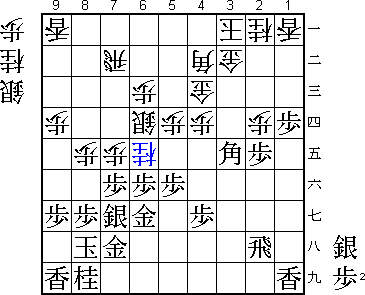
A desperate attempt to get the attack going, but this loss of a knight is
very big.
65.P6fx6e 3/252 0/262
66.S6dx6e 0/252 0/262
67.P2ex2d 16/268 0/262
68.P*2g 0/268 4/266
69.R2hx2g 0/268 0/266
70.P*2e 0/268 10/276
71.S*6a! 10/278 0/276
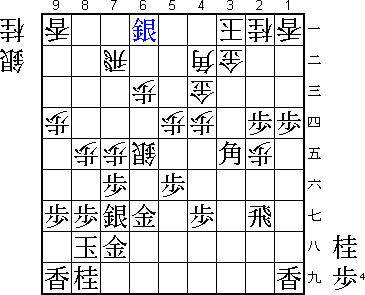
The finishing touch. If white plays 72.R6b followed by Rx6a, then black uses
this time to give his attack decisive strength by P1c+ and P2c+.
72.R7b-7a 0/278 8/284
73.S6a-5b= 8/286 0/284
Now the game is also over quickly.
74.G4c-3d 0/286 2/286
75.R2g-3g 1/287 0/286
76.P7ex7f 0/287 13/299
77.P2d-2c+ 0/287 0/299
78.G3bx2c 0/287 0/299
79.B3ex4d 0/287 0/299
80.P7fx7g+ 0/287 0/299
81.N8ix7g 0/287 0/299
Resigns 0/287 0/299
Time: 04:47:00 04:59:00
The threat Rx3d has to be defended against (Rx3d Gx3d G*2b is mate), but after
82.P*3f Rx3f P*3e Bx7a+ Px3f R*4a K3b Nx6e white has no hope.
A Tanigawa-like game by Miura, who is now only one win away from his first
Shinjin-O title.
